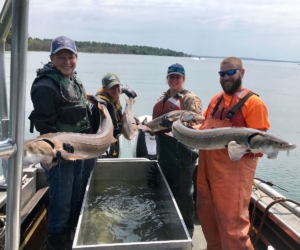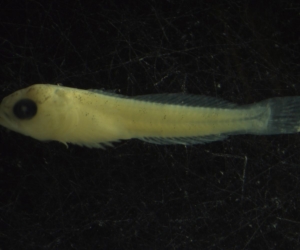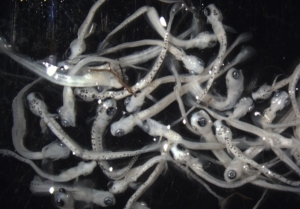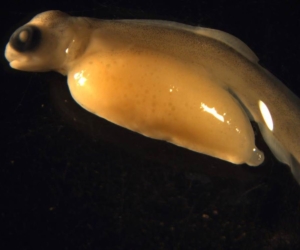Fisheries Management and Aquaculture
Continue reading to see how CFRE contributes to fisheries management and aquaculture.
Lake Sturgeon
CFRE faculty, staff, and students have worked with personnel from the Michigan Department of Natural Resources and the US Fish and Wildlife Service to understand the population characteristics (Bauman et al. 2011) and movements (Gerig et al. 2011) of Lake Sturgeon in the St. Marys River.
Currently, we are collaborating with several state, federal, provincial, and tribal agencies to establish an array of acoustic receivers in the river that will allow us to gain further insights into the movements and habitat use of sub-adult and adult Lake Sturgeon. What we learn will help guide management of this culturally and ecologically important native species, which is listed as threatened by the State of Michigan.
USGS Larval Fish
LSSU continues to work with Ed Roseman (USGS) to better understand larval fish dynamics in the St. Marys River.
Since 2013, we have sampled larval fish in the Little Rapids area where hydrological connectivity was restored in 2016-2017. In 2021, we also sampled the Cloverland hydropower canal.
The goals of these projects are to:
- Understand use of the restored Little Rapids site by spawning fishes
- Gain insights into which larval fishes are produced in the river and which drift downstream from Lake Superior into the river
Lake Whitefish Recruitment
Lake Whitefish are an economically, recreationally, and culturally important species in the Great Lakes. However, this important species has been on the decline since the 1990s, coinciding with the invasion of zebra and quagga mussels. Invasive mussels have profound impacts on aquatic systems, especially in the lower food web. One hypothesis for Lake Whitefish declines is decreased zooplankton prey, a critical food source for fish during their larval stage.
CFRE, in collaboration with several tribal, state, and federal agencies is conducting research on Lakes Michigan, Huron, and Superior to further understand the causes of declining Lake Whitefish populations.
Photo Credit: Little Traverse Bay Bands of Odawa Indians
Fish Gut Microbiome
The gut microbiome is known to affect the health, physiology, and behavior of vertebrates, but very little is known about these relationships in fishes. With support from the Cooperative Institute for Great Lakes Research, CFRE personnel are working with collaborators from St. Louis University and Washington University in St. Louis to begin to unravel the mysteries of the gut microbiome and virome in Atlantic Salmon. Specifically, we are determining how the gut microbiome and virome differ:
- Between age-0 and adult Atlantic Salmon
- Between adult Atlantic Salmon reared at different hatcheries
- Within age-0 salmon before and after being vaccinated for Bacterial Kidney Disease
We anticipate that our results will lead to adjustments in hatchery rearing practices to maximize survival of stocked salmon.





